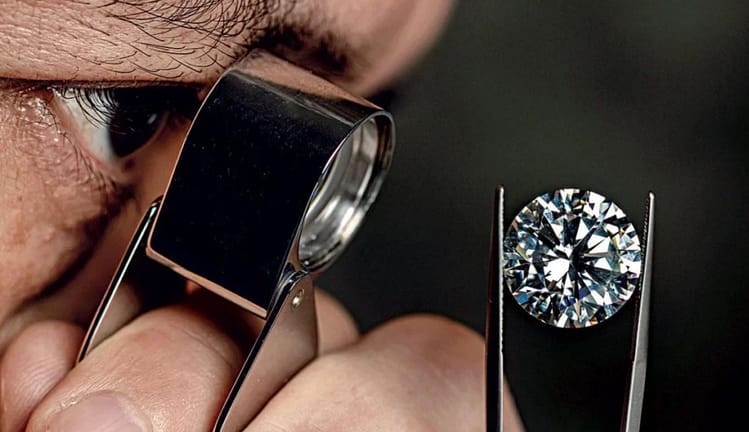Are you considering buying lab-grown diamonds? Are you curious about the pros and cons of this new technology? This article will provide you with a comprehensive overview of the rise of lab-grown diamonds, and the many advantages and disadvantages associated with them. Read on to discover what you need to know before making your purchase.
1. Understanding Lab-Grown Diamonds
The rise of lab-grown diamonds has been a recent development in the jewellery industry. Lab-grown diamonds are also known as synthetic diamonds, or man-made diamonds. These diamonds are created in a controlled laboratory environment using advanced technologies that replicate the process of natural diamond formation.
Lab-grown diamonds are completely real and have the same physical and chemical properties as natural diamonds. They are graded according to the same standards as natural diamonds, and can be certified by the same gemmological laboratories.
It is important to understand the differences between lab-grown and natural diamonds. Lab-grown diamonds are created in a laboratory and are not mined from the earth. They are cheaper and more accessible than natural diamonds, and can be produced in a variety of sizes and shapes. However, lab-grown diamonds are not as rare as natural diamonds, and do not have the same value or resale potential.
It is also important to understand the ethical implications of lab-grown diamonds. Lab-grown diamonds are generally considered to be more ethical than natural diamonds, as they do not require the destruction of the environment or exploitation of workers in diamond mines. However, some lab-grown diamonds may be produced using unethical practices, such as the use of child labour or hazardous working conditions.
For more information on lab-grown diamonds, please refer to GIA’s guide on lab-grown diamonds.
2. Environmental Impact of Lab-Grown Diamonds
Lab-grown diamonds have been touted as a more sustainable alternative to mined diamonds, but what is their environmental impact? While lab-grown diamonds do not have the same negative impact on the environment as mining, their production still requires energy and resources.
The process of creating lab-grown diamonds involves using large amounts of energy to create the high temperatures and pressures needed to mimic the natural diamond formation process. This energy use contributes to carbon emissions and other environmental impacts associated with energy production.
Additionally, lab-grown diamond production requires the use of chemicals and materials, some of which may be harmful to the environment if not properly managed. However, the industry has made strides in recent years to improve their sustainability practices, with some companies using renewable energy sources and implementing closed-loop systems to reduce waste.
Overall, while lab-grown diamonds may have a lower environmental impact than mined diamonds, their production still has an impact on the environment. It is important for consumers to consider the environmental impact of both options when making a purchasing decision.
For more information on the environmental impact of lab-grown diamonds, check out this article by Brilliant Earth.

3. Cost Comparison of Lab-Grown and Natural Diamonds
One of the most significant advantages of lab-grown diamonds is their cost. Lab-grown diamonds are generally less expensive than natural diamonds. The price of natural diamonds is determined by several factors, including rarity, demand, and production costs. However, lab-grown diamonds are produced in controlled environments, so the production process is more efficient, and the diamonds can be produced in large quantities. This results in a lower cost per carat for lab-grown diamonds.
According to a report by Bain & Company, lab-grown diamonds are typically 30-40% less expensive than natural diamonds. The price difference is even more significant for larger diamonds. For example, a 1-carat natural diamond can cost around $4,000, while a lab-grown diamond of the same size can cost as little as $1,500.
However, it’s important to note that the price of lab-grown diamonds varies depending on the quality, size, and shape. Some lab-grown diamonds can be more expensive than natural diamonds, particularly if they are of high quality or have unique characteristics.
In conclusion, the cost of lab-grown diamonds is generally lower than natural diamonds. This makes them an attractive option for consumers who want a high-quality diamond at a more affordable price.
4. Ethical Considerations of Lab-Grown Diamonds
The ethical considerations of lab-grown diamonds are often discussed when considering the pros and cons of this type of diamond. Generally, lab-grown diamonds are considered to be more ethical than mined diamonds due to the lack of environmental impact involved in the production process. Additionally, lab-grown diamonds are free from the human rights violations and unethical labor practices that are sometimes associated with the diamond mining industry.
However, some experts have raised concerns about the lack of oversight in the lab-grown diamond industry. As the technology to create lab-grown diamonds continues to evolve, there is an increasing risk of synthetic diamonds being misrepresented as natural diamonds. To combat this, the International Gemological Institute (IGI) has developed a certification program that is designed to detect and authenticate lab-grown diamonds.
The IGI has also created a Responsible Sourcing Program to ensure that the lab-grown diamonds they certify are produced in an ethical and responsible manner. This includes ensuring that the diamonds are produced in an environmentally-friendly way and that the labor involved in the production process is not subject to exploitation.
In addition to the IGI’s certification program, the Responsible Jewellery Council (RJC) has developed a set of ethical standards for the lab-grown diamond industry. These standards cover topics such as labor practices, environmental impact, and consumer protection. The RJC’s standards are designed to ensure that all lab-grown diamonds are produced in an ethical manner.
Overall, the ethical considerations of lab-grown diamonds are
5. Quality and Durability of Lab-Grown Diamonds
Lab-grown diamonds are becoming increasingly popular as an alternative to natural diamonds. They are created in a laboratory using advanced technology and are chemically, physically, and optically identical to their natural counterparts. One of the main advantages of lab-grown diamonds is that they are often of higher quality and more durable than natural diamonds.
Lab-grown diamonds are produced in a controlled environment, which means that they are often of higher quality and clarity than natural diamonds. This means that they have fewer imperfections and inclusions, making them more brilliant and sparkly. They also have superior durability, as they are created in a lab using advanced technology, making them less prone to scratches and chipping.
Lab-grown diamonds are also available in a variety of colors, including yellow, pink, and blue. This makes them a great choice for those looking for a unique and stylish diamond. Furthermore, they are often more affordable than their natural counterparts, making them a great choice for those on a budget.
In conclusion, lab-grown diamonds are a great option for those looking for a high-quality, durable diamond at an affordable price. They are chemically, physically, and optically identical to natural diamonds and offer a variety of colors and clarity options. Furthermore, they are often more affordable than their natural counterparts, making them a great choice for those on a budget.

6. Potential of Lab-Grown Diamonds in the Future
Lab-grown diamonds have tremendous potential in the future. They are not only cheaper but also eco-friendly as compared to mined diamonds. Lab-grown diamonds are produced in a controlled environment and the process involves less energy consumption and water usage. Moreover, they are free from any ethical concerns such as child labor and worker exploitation.
The demand for lab-grown diamonds is increasing rapidly as more people are becoming aware of their benefits. The global lab-grown diamond market is expected to grow at a CAGR of 6.5% from 2020 to 2027. Lab-grown diamonds are also gaining popularity among millennials who are conscious about the environment and ethical issues.
Lab-grown diamonds have the potential to revolutionize the diamond industry. They offer a sustainable alternative to mined diamonds and can help reduce the environmental impact of diamond mining. They can also provide a consistent supply of diamonds that are not affected by the political and social issues that often plague the diamond industry.
Overall, lab-grown diamonds have a bright future and are expected to become a mainstream choice for consumers who want to purchase diamonds that are both affordable and ethical.
Conclusion:
Lab-grown diamonds, also known as synthetic or man-made diamonds, have emerged as a contemporary alternative to natural diamonds. Created in controlled lab environments, these diamonds possess the same physical and chemical attributes as their natural counterparts. They offer a more affordable and ethically sound option, sidestepping the environmental and human rights concerns associated with traditional diamond mining. However, like all innovations, they come with their own set of challenges, such as potential misrepresentation in the market. As technology advances and awareness grows, lab-grown diamonds are poised to play a significant role in the future of the jewelry industry, offering consumers a blend of beauty, ethics, and affordability.
